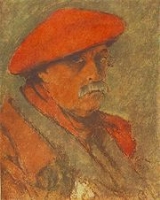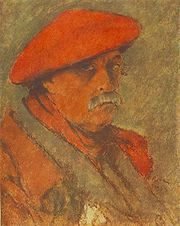
József Rippl-Rónai
Encyclopedia

Kingdom of Hungary
The Kingdom of Hungary comprised present-day Hungary, Slovakia and Croatia , Transylvania , Carpatho Ruthenia , Vojvodina , Burgenland , and other smaller territories surrounding present-day Hungary's borders...
painter.
He was born in Kaposvár. After his studies at the High School there, he went to study in Budapest
Budapest
Budapest is the capital of Hungary. As the largest city of Hungary, it is the country's principal political, cultural, commercial, industrial, and transportation centre. In 2011, Budapest had 1,733,685 inhabitants, down from its 1989 peak of 2,113,645 due to suburbanization. The Budapest Commuter...
, where he obtained a degree in pharmacology. In 1884 he travelled to Munich to study painting at the Academy. Two years later he obtained a grant which enabled him to move to Paris and study with Munkácsy
Mihály Munkácsy
Mihály Munkácsy was a Hungarian painter, who lived in Paris and earned international reputation with his genre pictures and large scale biblical paintings.-Early Years of Munkácsy:...
. In 1888 he met the members of Les Nabis
Les Nabis
Les Nabis were a group of Post-Impressionist avant-garde artists who set the pace for fine arts and graphic arts in France in the 1890s. Initially a group of friends interested in contemporary art and literature, most of them studied at the private art school of Rodolphe Julian in Paris in the...
and under their influence he painted his first important work, The Inn at Pont-Aven, a deeply-felt work notable for its dark atmosphere. His first big success was his painting My Grandmother (1894). He also painted in a portrait of Hungarian pianist and composer Zdenka Ticharich
Zdenka Ticharich
Zdenka Ticharich was a Hungarian pianist, music educator and composer.-Biography:Zdenka Ticharich was born in Budapest, Hungary...
(1921).
Later he returned to Hungary, where critical reception was at first lukewarm, but he eventually had a very successful exhibition entitled "Rippl-Rónai Impressions 1890-1900". He believed that for an artist not only is his body of work significant, but also his general modus vivendi, even including the clothes he wore. He thus became interested in design, which led to commissions such as the dining room and the entire furnishings of the Andrássy palace, and a stained-glass window in the Ernst Museum, (both in Budapest). Between 1911 and 1913 his exhibitions in Frankfurt, Munich and Vienna were highly successful. His last major work, a portrait of his friend Zorka, was painted in 1919, and in 1927 he died at his home, the Villa Roma in Kaposvár.

